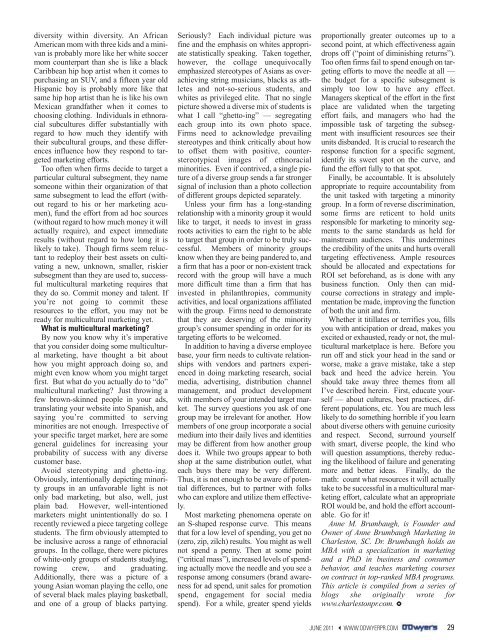INTERNATIONAL & MULTICULTURAL ISSUE - Odwyerpr.com
INTERNATIONAL & MULTICULTURAL ISSUE - Odwyerpr.com
INTERNATIONAL & MULTICULTURAL ISSUE - Odwyerpr.com
You also want an ePaper? Increase the reach of your titles
YUMPU automatically turns print PDFs into web optimized ePapers that Google loves.
diversity within diversity. An AfricanAmerican mom with three kids and a minivanis probably more like her white soccermom counterpart than she is like a blackCaribbean hip hop artist when it <strong>com</strong>es topurchasing an SUV, and a fifteen year oldHispanic boy is probably more like thatsame hip hop artist than he is like his ownMexican grandfather when it <strong>com</strong>es tochoosing clothing. Individuals in ethnoracialsubcultures differ substantially withregard to how much they identify withtheir subcultural groups, and these differencesinfluence how they respond to targetedmarketing efforts.Too often when firms decide to target aparticular cultural subsegment, they namesomeone within their organization of thatsame subsegment to lead the effort (withoutregard to his or her marketing acumen),fund the effort from ad hoc sources(without regard to how much money it willactually require), and expect immediateresults (without regard to how long it islikely to take). Though firms seem reluctantto redeploy their best assets on cultivatinga new, unknown, smaller, riskiersubsegment than they are used to, successfulmulticultural marketing requires thatthey do so. Commit money and talent. Ifyou’re not going to <strong>com</strong>mit theseresources to the effort, you may not beready for multicultural marketing yet.What is multicultural marketing?By now you know why it’s imperativethat you consider doing some multiculturalmarketing, have thought a bit abouthow you might approach doing so, andmight even know whom you might targetfirst. But what do you actually do to “do”multicultural marketing? Just throwing afew brown-skinned people in your ads,translating your website into Spanish, andsaying you’re <strong>com</strong>mitted to servingminorities are not enough. Irrespective ofyour specific target market, here are somegeneral guidelines for increasing yourprobability of success with any diversecustomer base.Avoid stereotyping and ghetto-ing.Obviously, intentionally depicting minoritygroups in an unfavorable light is notonly bad marketing, but also, well, justplain bad. However, well-intentionedmarketers might unintentionally do so. Irecently reviewed a piece targeting collegestudents. The firm obviously attempted tobe inclusive across a range of ethnoracialgroups. In the collage, there were picturesof white-only groups of students studying,rowing crew, and graduating.Additionally, there was a picture of ayoung Asian woman playing the cello, oneof several black males playing basketball,and one of a group of blacks partying.Seriously? Each individual picture wasfine and the emphasis on whites appropriatestatistically speaking. Taken together,however, the collage unequivocallyemphasized stereotypes of Asians as overachievingstring musicians, blacks as athletesand not-so-serious students, andwhites as privileged elite. That no singlepicture showed a diverse mix of students iswhat I call “ghetto-ing” — segregatingeach group into its own photo space.Firms need to acknowledge prevailingstereotypes and think critically about howto offset them with positive, counterstereotypicalimages of ethnoracialminorities. Even if contrived, a single pictureof a diverse group sends a far strongersignal of inclusion than a photo collectionof different groups depicted separately.Unless your firm has a long-standingrelationship with a minority group it wouldlike to target, it needs to invest in grassroots activities to earn the right to be ableto target that group in order to be truly successful.Members of minority groupsknow when they are being pandered to, anda firm that has a poor or non-existent trackrecord with the group will have a muchmore difficult time than a firm that hasinvested in philanthropies, <strong>com</strong>munityactivities, and local organizations affiliatedwith the group. Firms need to demonstratethat they are deserving of the minoritygroup’s consumer spending in order for itstargeting efforts to be wel<strong>com</strong>ed.In addition to having a diverse employeebase, your firm needs to cultivate relationshipswith vendors and partners experiencedin doing marketing research, socialmedia, advertising, distribution channelmanagement, and product developmentwith members of your intended target market.The survey questions you ask of onegroup may be irrelevant for another. Howmembers of one group incorporate a socialmedium into their daily lives and identitiesmay be different from how another groupdoes it. While two groups appear to bothshop at the same distribution outlet, whateach buys there may be very different.Thus, it is not enough to be aware of potentialdifferences, but to partner with folkswho can explore and utilize them effectively.Most marketing phenomena operate onan S-shaped response curve. This meansthat for a low level of spending, you get no(zero, zip, zilch) results. You might as wellnot spend a penny. Then at some point(“critical mass”), increased levels of spendingactually move the needle and you see aresponse among consumers (brand awarenessfor ad spend, unit sales for promotionspend, engagement for social mediaspend). For a while, greater spend yieldsproportionally greater out<strong>com</strong>es up to asecond point, at which effectiveness againdrops off (“point of diminishing returns”).Too often firms fail to spend enough on targetingefforts to move the needle at all —the budget for a specific subsegment issimply too low to have any effect.Managers skeptical of the effort in the firstplace are validated when the targetingeffort fails, and managers who had theimpossible task of targeting the subsegmentwith insufficient resources see theirunits disbanded. It is crucial to research theresponse function for a specific segment,identify its sweet spot on the curve, andfund the effort fully to that spot.Finally, be accountable. It is absolutelyappropriate to require accountability fromthe unit tasked with targeting a minoritygroup. In a form of reverse discrimination,some firms are reticent to hold unitsresponsible for marketing to minority segmentsto the same standards as held formainstream audiences. This underminesthe credibility of the units and hurts overalltargeting effectiveness. Ample resourcesshould be allocated and expectations forROI set beforehand, as is done with anybusiness function. Only then can midcoursecorrections in strategy and implementationbe made, improving the functionof both the unit and firm.Whether it titillates or terrifies you, fillsyou with anticipation or dread, makes youexcited or exhausted, ready or not, the multiculturalmarketplace is here. Before yourun off and stick your head in the sand orworse, make a grave mistake, take a stepback and heed the advice herein. Youshould take away three themes from allI’ve described herein. First, educate yourself— about cultures, best practices, differentpopulations, etc. You are much lesslikely to do something horrible if you learnabout diverse others with genuine curiosityand respect. Second, surround yourselfwith smart, diverse people, the kind whowill question assumptions, thereby reducingthe likelihood of failure and generatingmore and better ideas. Finally, do themath: count what resources it will actuallytake to be successful in a multicultural marketingeffort, calculate what an appropriateROI would be, and hold the effort accountable.Go for it!Anne M. Brumbaugh, is Founder andOwner of Anne Brumbaugh Marketing inCharleston, SC. Dr. Brumbaugh holds anMBA with a specialization in marketingand a PhD in business and consumerbehavior, and teaches marketing courseson contract in top-ranked MBA programs.This article is <strong>com</strong>piled from a series ofblogs she originally wrote forwww.charlestonpr.<strong>com</strong>. JUNE 2011 WWW.ODWYERPR.COM 29
















